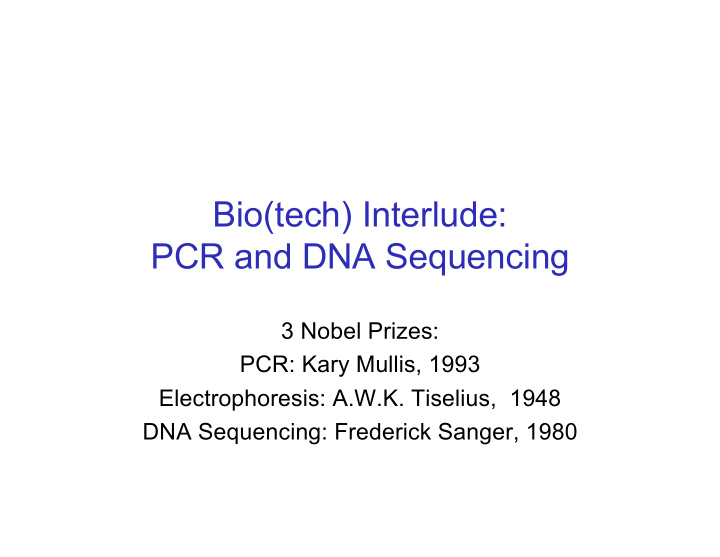



Bio(tech) Interlude: PCR and DNA Sequencing 3 Nobel Prizes: PCR: Kary Mullis, 1993 Electrophoresis: A.W.K. Tiselius, 1948 DNA Sequencing: Frederick Sanger, 1980
PCR 2: 95ºC 1: 25ºC 3: 60ºC G A T A A G 5’ 3’ T 3’ 5’ T C T G T 5: 72ºC 6: 72ºC 4: 72ºC C A A T C T A T A C G T
Hot spring, near Great Fountain Geyser, Yellowstone National Park
PCR Ingredients: many copies of deoxy nucleotide triphosphates many copies of two primer sequences (~20 nt each) readily synthesized many copies of Taq polymerase ( Thermus aquaticus ), readily available commercialy as little as 1 strand of template DNA a programmable “thermal cycler” Amplification: million to billion fold Range: up to 2k bp routinely; 50k with other enzymes & care
Why PCR? PCR is important for all the reasons that filters and amplifiers are important in electronics, e.g., sample size is reduced from grams of tissue to a few cells, can pull out small signal amidst “noisy” background Very widely used ; forensics, archeology, cloning, sequencing, …
DNA Forensics E.g. FBI “CODIS” (combined DNA indexing system) data base As of 1/2013, over 10,142,600 offender profiles Picked 13 “short tandem repeats”, i.e., variable-length regions of human genome flanked by (essentially) invariant sequences (primer targets), several alleles common at each locus, of which you have 2 Amplify each from, e.g., small spot of dried blood Measure product lengths (next slides) http://www.fbi.gov/about-us/lab/biometric-analysis/codis http://www.dna.gov/solving-crimes/cold-cases/howdatabasesaid/codis/
Gel Electrophoresis DNA/RNA backbone is negatively charged (they’re acids) Molecules moves slowly in gels under an electric field agarose gels for large molecules polyacrylamide gels for smaller ones Smaller molecules move faster So, you can separate DNAs & RNAs by size Nobel Chem prize, 1948 Arne Wilhelm Kaurin Tiselius
lane 1 lane 2 lane 3 lane 4 lane 5 - 10,000 bp 3,000 bp 500 bp +
DNA Sequencing – Sanger Method Like one-cycle, one-primer PCR Suppose 0.1% of A’s: are di- deoxy adenosine’s; 5’ backbone can’t extend 3’ carry a green florescent dye OH Separate by capillary gel electrophoresis If frags of length 42, 49, 50, 55 … glow green, those positions are A’s Ditto C’s (blue), G’s (yellow), T’s (red)
DNA Sequencing Sanger with capillary electrophoresis sample + -
Sequencing A Genome E.g., human Highly automated genome project: Typical Sanger “read” about 600 nt ≈ 30Gbases and ≈ 3x10 9 /600x10 “Whole Genome Shotgun” approach: = 5x10 7 reads randomly fragment (many copies of) genome sequence many, enough to cover each base 10x or more times reassemble by computer a e g b f c d Complications: repeated region, missed regions, sequencing errors, chimeric DNA fragments, … But overall accuracy ~10 -4 , if careful
“Next Generation” Sequencing Many technical improvements to Sanger approach over many years, culminating in highly automated machines used for the HGP Since then, many innovative new ideas/products: • Helicos: single molecule flourescence tethered to flow cell • Illumina: colony PCR; reversible dye terminator • Ion Torrent: semiconductor detection of ions released by polymerase • Roche 454: emulsion PCR; pyro sequencing • Oxford Nanopore • Pacific Biosciences: single tethered polymerases in “zero mode waveguide” nano-wells, circularized DNA, “real time” • ABI SOLiD: emulsion PCR, sequence by ligation, “color-space” • Complete Genomics: rolling circle replication/DNA nanoballs Technology is changing rapidly!
“Next Generation” Sequencing ~1 billion microscopic PCR “colonies” on 1x2” slide “Read” ~50-150bp of sequence from (1 or 2) ends of each Ends fluorescently labeled, blocked, chemically cycled Automated: takes a few days; ~ 100 G bases/day Costs a few thousand dollars Generates terabytes of data (mostly images) I,e., ~ 30x human genome/day (you need 25x-50x to assemble) Other approaches: long reads, single molecules,… Technology is changing rapidly!
� � b http://www.technologyreview.com/sites/default/files/legacy/pgenome_x220.jpghttp://bioinformatics.oxfordjournals.org/content/25/17/2194/F1.large.jpg http://bioinformatics.oxfordjournals.org/content/25/17/2194/F1.large.jpg Fig from: Shendure and Ji 2008. “Next-Generation DNA Sequencing..” Nature Biotechnol 26 (10) (October): 1135–1145. doi:10.1038/nbt1486.
Modern DNA Sequencing A table-top box the size of your oven (but costs a bit more … ;-) can generate ~100 billion BP of DNA seq/day; i.e. = 2008 genbank, = 30x your genome
18
Figure 3: Illumina Sequencing Technology Outpaces Moore’s Law for the Price of Whole Human Genome Sequencing $100,000,000 $10,000,000 $1,000,000 $100,000 $10,000 $1,000 Cost per Genome Moore’s Law $100 Sep 01 Jul 02 May 03 Mar 04 Jan 05 Nov 05 Sep 06 Jul 07 May 08 Mar 09 Jan 10 Nov 10 Sep 11 Jul 12 May 13 Mar 14 19
Table 1: HiSeq X Ten Preliminary Performance Parameters* Dual Flow Cell Single Flow Cell Output/Run 1.6–1.8 Tb 800–900 Gb Reads Passing ≤ 6 billion ≤ 3 billion Filter † Supported Read 2 × 150 Length Run Time < 3 days Quality ≥ 75% of bases above Q30 at 2 × 150 bp *Speci fj cations based on Illumina PhiX control library at supported cluster densities (between 1,255–1,412 K clusters/mm 2 ). Supported library preparation kit includes TruSeq Nano DNA HT kit with 350 bp target insert size and HiSeq X HD reagents. HiSeq X was designed and optimized for human whole-genome sequencing; other applications and species are not supported. 20 † Single-end reads.
Pacific Biosciences Primer Template Polymerase Phospholinked Zero-Mode nucleotides Waveguides http://files.pacb.com/pdf/PacBio_RS_II_Brochure.pdf http://www.globenewswire.com/NewsRoom/Attachment/18068
Advantages: single molecules Pacific Biosciences long reads direct CH 3 detection Disadvantages: throughput error rate; (circularize?) http://www.pacificbiosciences.com/img/assets/smrt_sequencing_advantage_readlength_lg.png
Oxford Nanopore Prerelease claims ≈ 100k read lengths, 150Mb in 6 hrs, $1000 http://www.nanoporetech.com/uploads/Technology_New/MinION/MinION_117.jpg http://www.nanoporetech.com/uploads/Technology_New/Introduction_To_Nanopore_Sensing/Nanopore_sensing_101_0_rs.jpg
Personal Genomes 2001: ~$2.7 billion (Human Genome Project) 2003: ~$300 million 2007: ~$1 million 2008: ~$60 thousand 2009: ~$4400 2014: ~$1000 (?) bioinformatics not included…
Summary PCR allows simple in vitro amplification of minute quantities of DNA (having pre-specified boundaries) Sanger sequencing uses a PCR-like setup with modified chemistry to generate varying length prefixes of a DNA template with the last nucleotide of each color-coded gel electrophoresis to separate DNA by size, giving sequence Sequencing random overlapping fragments allows genome sequencing (and many other applications) “Next Gen” sequencing: many innovations throughput up, cost down (lots!)
Recommend
More recommend